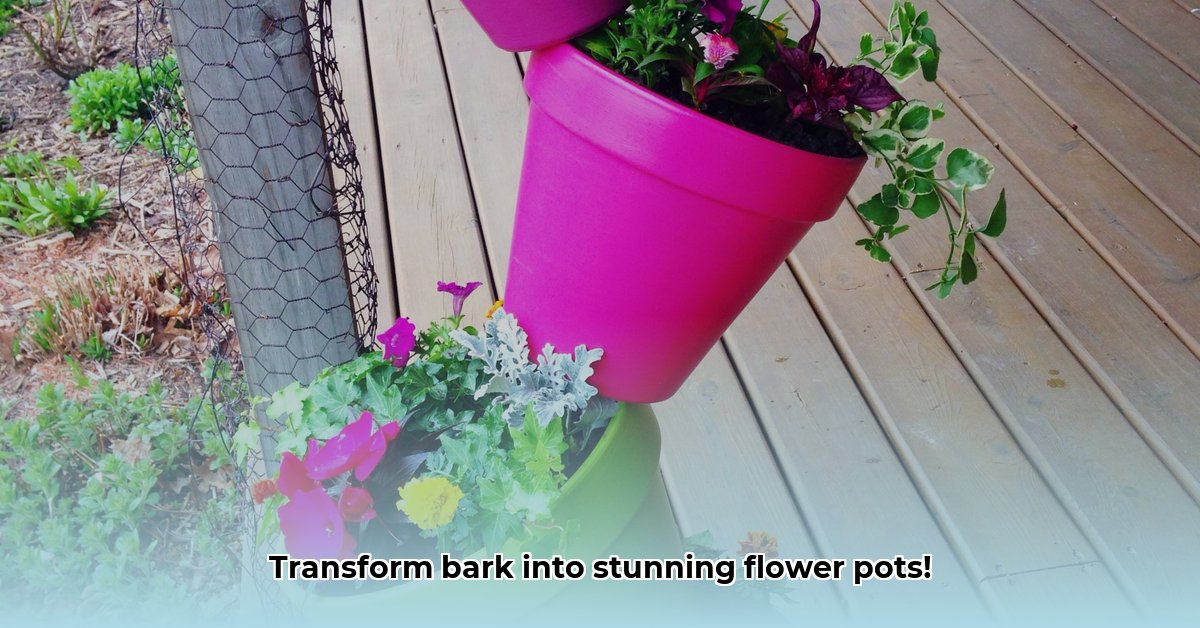Give Your Flower Pots a Natural Makeover with Bark
Want to add a touch of rustic charm to your home or garden? This tutorial will guide you through the process of decorating flower pots with bark, transforming ordinary containers into unique, eye-catching displays. Whether you’re a seasoned DIY enthusiast or just starting out, you’ll find these techniques easy to follow and inspiring.
Gathering Your Supplies
Before we begin, let’s gather our materials. This project offers flexibility, allowing you to choose materials that suit your style and budget.
Bark Selection
- Birch Bark: Known for its smooth, light-colored surface, birch bark offers a clean, modern aesthetic.
- Pine Bark: For a more rustic, textured look, pine bark brings a touch of woodland charm.
- Cedar Bark: Warm tones and natural insect-repelling qualities make cedar an excellent choice.
- Repurposed Bark: Consider using bark from fallen branches for an eco-friendly approach. Check local parks (with permission!) or your own backyard for readily available materials.
Other Essential Materials
The following table outlines the materials you’ll need based on your chosen project:
| Material | Covering Existing Pots | Creating Wooden Containers |
|---|---|---|
| Wooden Bark | ✅ | ✅ |
| Flower Pot (Terracotta, tin, glass) | ✅ | |
| Wooden Planks/Container | ✅ | |
| Adhesive (Two-part epoxy, PVA glue, or wood glue) | ✅ | ✅ |
| Pruning Shears/Scissors | ✅ | ✅ |
| Drill & Bits | ✅ | |
| Liner (Plastic or Burlap) | ✅ | |
| Sealant (Optional) | ✅ | |
| Elastic Bands/Twine | ✅ | ✅ |
| Paintbrush (Optional) | ✅ | ✅ |
Preparing Your Materials
Prepping the Bark
- Soaking: If the bark is dry, soak it in warm water for 30-60 minutes to increase pliability and prevent cracking.
- Cleaning: Gently brush the bark to remove dirt, dust, or debris. Allow it to dry completely before using.
- Treating (Optional): Consider treating the bark with a natural sealant or insecticide to prevent rot and insect infestation. Some research suggests this may not be necessary for all bark types, especially if the pots are used indoors.
Prepping the Pots
- Cleaning: Ensure your existing flower pots are clean and dry.
- Drainage: If building wooden containers, drill drainage holes. The number of holes depends on the container size.
- Sealing & Lining (Wooden Containers): Apply sealant to the inside and outside of wooden containers to protect the wood and extend its lifespan. Adding a liner can further protect the wood and simplify repotting.
Applying the Bark
Birch Bark Technique (for Terracotta Pots)
- Soften and Smooth: Soak birch bark and smooth any rough patches.
- Create a Template: Wrap bark around the pot, trim excess, and secure with elastic bands to dry (approximately 24 hours).
- Prime and Paint (Optional): Apply diluted PVA glue to the pot as a primer. Paint the rim and base for a polished look.
- Apply the Bark: Apply PVA glue to the inside of the dried bark pieces. Position the bark on the pot and secure with elastic bands. Allow to dry for 24 hours.
- Finishing Touches: Remove elastic bands. Add natural embellishments (dried flowers, twigs) with hot glue. Seal with a clear varnish (optional).
Other Bark and Container Techniques
- Upcycled Cans and Tree Bark: Arrange bark pieces on the can and secure with hot glue. Seal (optional).
- Carved Log Planters: Hollow out a section of a log, sand the exterior, apply varnish, and insert a liner.
Finishing Touches and Design Ideas
- Natural Embellishments: Consider adding moss, pine cones, or twigs to log planters.
- Personalization: Wood burn designs or attach metal tags to log planters.
- Preservation: Line log planters with plastic sheeting and experiment with natural oils or wood preservatives to slow down decomposition.
Choosing the Right Plants
Select plants that thrive in the conditions your bark-covered pots provide. Succulents, cacti, and drought-tolerant plants like lavender and rosemary are excellent choices. Consider the plant’s root system and choose a pot size accordingly.
Maintaining Your Bark Creations
- Watering: Avoid overwatering, as excessive moisture can lead to rot.
- Cleaning: Wipe the bark down occasionally with a damp cloth.
- Resealing: Reapply sealant to wooden containers every year or two to maintain weather resistance.
By following these steps and letting your creativity guide you, you can transform ordinary flower pots into stunning, one-of-a-kind pieces that showcase the natural beauty of bark. Don’t be afraid to experiment with different bark types, container styles, and embellishments to create personalized works of art for your home or garden.
- NYT Connections Answer: Hedgehog, Pineapple, Cactus The Spiky Things Explained - April 20, 2025
- How to Clean a Wool Carpet: A Comprehensive Guide - April 20, 2025
- How to Clean a Pleather Couch: A Complete Guide - April 20, 2025










